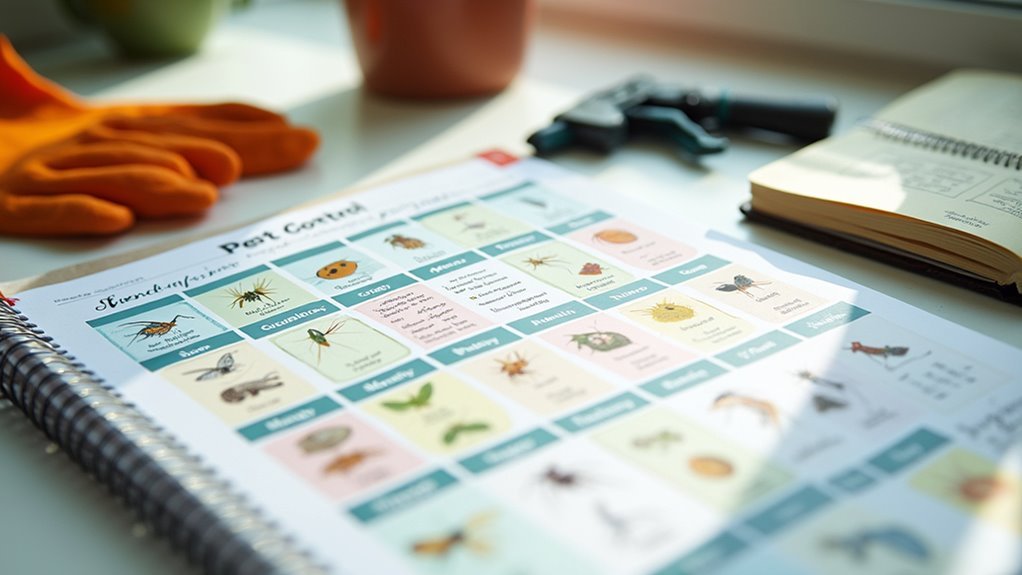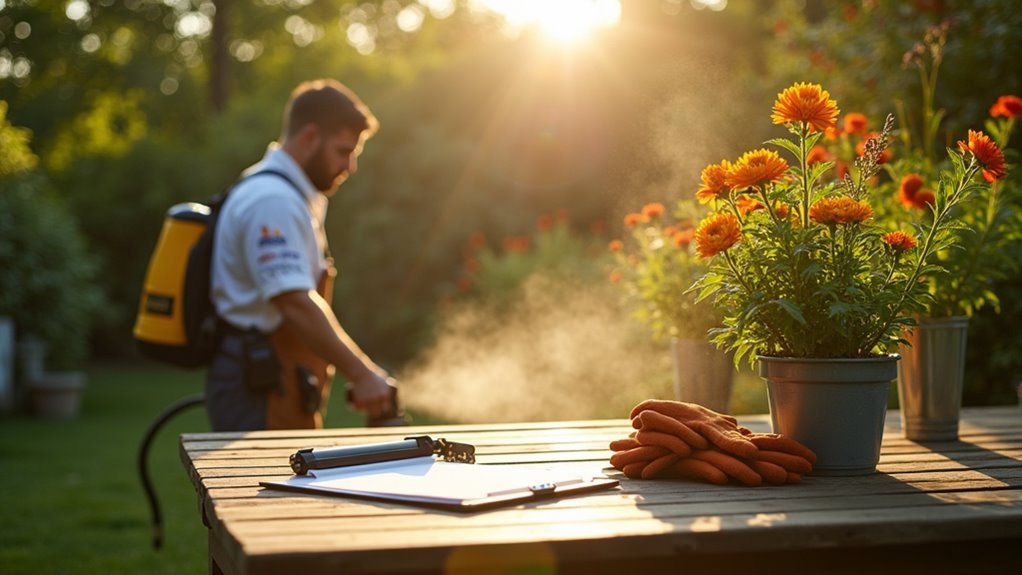You’ll need to align your pest control efforts with seasonal patterns to achieve maximum effectiveness. Start with spring foundation sealing and gutter cleaning from March to May, then focus on eliminating standing water and maintaining screens during summer months. Fall requires sealing entry points and removing outdoor debris before rodents seek winter shelter. Winter monitoring should target attics and basements while maintaining proper food storage. This strategic approach will transform your home into a year-round fortress against unwanted invaders.
Understanding Seasonal Pest Patterns and Life Cycles

Why do pest problems seem to surge at certain times of the year while remaining manageable during others? Understanding seasonal pest control patterns and pest life cycles gives you the edge you need for effective management.
You’ll notice mosquitoes peak during summer heat, while rodents seek indoor shelter when winter arrives. Ants become active in spring, and termites swarm during warmer weather, potentially causing structural damage.
Cockroaches reproduce rapidly in warm conditions, making timing vital for intervention. Bed bugs often increase during travel-heavy holiday seasons when people move between locations.
Creating Your Property Assessment and Vulnerability Map
Before you can develop an effective pest control strategy, you’ll need to conduct a thorough property assessment that maps every potential vulnerability on your grounds. Start by conducting a thorough inspection of windows, doors, foundation cracks, and utility openings. Document problem areas with photos and measurements to track changes over time.
| Assessment Area | Key Focus Points |
|---|---|
| Entry Points | Windows, doors, foundation gaps |
| Moisture Sources | Leaky pipes, poor drainage areas |
| Food Attractants | Pet food, garden debris, trash |
| Seasonal Vulnerabilities | Weather-related damage, temperature changes |
| Documentation | Photos, measurements, detailed notes |
This proactive approach enables targeted treatments rather than reactive pest control methods. Update your vulnerability map seasonally and consult local extension offices for regional pest prevention insights.
Building an Effective Seasonal Pest Control Calendar

You’ll maximize your pest control efforts by creating a seasonal calendar that identifies when specific pests are most active throughout the year.
This calendar should outline monthly activities like sealing entry points in winter, deep cleaning in early spring, and conducting thorough inspections during peak pest seasons.
Seasonal Pest Identification
While many homeowners react to pest problems after they’ve already occurred, you can gain a significant advantage by understanding which pests emerge during specific seasons and planning your control measures accordingly.
Recognizing seasonal pests and their behavior patterns allows you to implement preventive measures before infestations take hold.
Here’s what to monitor throughout the year:
- Spring: Ants, termites, and flies become active as temperatures rise.
- Summer: Mosquitoes, wasps, and spiders reach peak activity levels.
- Fall: Rodents seek indoor shelter while stink bugs invade homes.
- Winter: Cockroaches and stored product pests thrive in heated spaces.
Understanding these cycles helps you prevent infestations through targeted seasonal treatments.
Many pest control companies offer customized programs based on local pest behavior patterns.
Monthly Activity Planning
Since effective pest control requires consistent action rather than sporadic reactions, developing a month-by-month activity calendar transforms your approach from defensive to strategic.
Your seasonal calendar should begin with January’s entry point sealing, followed by spring property assessments documenting moisture sources and vulnerabilities.
Schedule regular inspections from March through October to catch early signs of pest infestations before they escalate.
Summer months demand attention to standing water removal, while September calls for thorough pest activity inspections.
Winter preparation includes insulating potential entry points against cold-weather invaders.
This proactive approach guarantees you’re implementing preventative measures year-round rather than scrambling during peak pest seasons.
Document your monthly findings to refine strategies and create targeted treatments that address seasonal pest patterns effectively.
Calendar Implementation Strategies
Building an effective seasonal pest control calendar requires translating your monthly planning into actionable systems that you’ll actually follow.
Your seasonal pest control strategy becomes powerful when you establish consistent implementation protocols that anticipate seasonal threats before they escalate.
Here’s how to execute your calendar effectively:
- Schedule specific monthly inspections – Set recurring reminders for sealing entry points in January and eliminating standing water in May to prevent peak pest seasons.
- Document and track activity patterns – Record monthly observations to identify vulnerabilities and adjust preventative treatments accordingly.
- Create seasonal checklists – Include deep cleaning in February and winterizing tasks in October to maintain a pest-free environment year-round.
- Engage local extension offices – Refine your calendar using regional pest guides and expert knowledge of local pest life cycles.
March Through May: Spring Protection Strategies

Spring’s arrival signals the beginning of peak pest activity, making March through May critical months for your pest control strategy.
You’ll need to focus on two essential areas: completing thorough exterior maintenance tasks and implementing early prevention methods before infestations take hold.
These proactive steps during spring’s early months will set the foundation for effective pest management throughout the warmer seasons.
Exterior Maintenance Tasks
As temperatures begin to warm in March, you’ll want to start your exterior maintenance by trimming back overgrown vegetation and clearing accumulated debris from around your home’s perimeter.
These simple steps eliminate hiding spots where ants, spiders, and other unwanted guests seek shelter.
Your spring exterior maintenance should include these essential tasks:
- Inspect and seal your home’s foundation – Check for cracks or gaps that provide entry points for pests
- Clean gutters thoroughly – Remove standing water where mosquitoes breed and multiply
- Trim vegetation properly – Cut back bushes and branches touching your house’s exterior
- Clear debris completely – Remove leaf piles, wood stacks, and clutter near foundations
These proactive measures help prevent common pests from establishing themselves and create a pest-free environment before pest issues escalate during warmer months.
Early Prevention Methods
When March arrives and winter’s grip loosens, you’ll need to shift into active prevention mode to stop pest problems before they start.
Begin your seasonal action plan by thoroughly inspecting your home for potential pest entry points, sealing any cracks or gaps you discover. These early prevention methods create an essential barrier against emerging pests.
April’s your window for implementing targeted strategies. Set traps and apply insecticides to combat ants and mosquitoes.
Clean gutters regularly, removing debris that creates breeding sites and moisture accumulation.
Professional pest control services can enhance your effective pest management approach during this pivotal period.
June Through August: Summer Pest Management
Summer’s intense heat and humidity create the perfect storm for pest activity, with mosquitoes reaching their peak breeding season while ants, cockroaches, and flies multiply rapidly in the warm conditions.
During these summer months, you’ll need aggressive pest control strategies to protect your home and outdoor gatherings.
Here’s your essential summer pest management plan:
- Weekly inspections – Monitor for ants, cockroaches, and other warm-weather pests that can quickly develop into serious infestations.
- Eliminate standing water – Remove mosquito breeding sites from gutters, planters, and yard containers.
- Seal entry points – Maintain screens and close gaps to prevent pests seeking shelter from heat.
- Deploy natural deterrents – Use repellents and traps during outdoor events to control mosquitoes and ticks.
Stay vigilant against wasps, flies, and fleas throughout these peak activity months.
September Through November: Fall Prevention Measures
As temperatures begin to drop, you’ll need to shift your focus from active pest management to prevention strategies that block entry points before winter arrives.
September marks the critical time to seal gaps and cracks throughout your home, since nearly 50% of rodent infestations start during fall and winter months.
September Shelter Prevention
September signals the start of pest migration season, and you’ll need to act quickly before rodents and insects begin their search for warm indoor shelter.
Effective pest control management requires proactive measures to eliminate potential entry points and hiding spots around your home.
Focus on these critical shelter prevention steps:
- Seal entry points – Inspect and close cracks, gaps, and utility openings where rodents can enter.
- Install rodent guards – Add protective barriers to vents and chimneys to block access routes.
- Remove outdoor debris – Clear brush piles, leaf accumulations, and clutter that provide pest shelter.
- Trim vegetation – Cut back plants and branches touching your home’s exterior walls.
These September actions greatly reduce your pest problems, as nearly 50% of rodent infestations occur during fall and winter months.
November Winter Preparation
November marks the final opportunity to winterize your home against pest invasions before freezing temperatures drive rodents and insects to seek indoor warmth.
Inspect and seal gaps around windows, doors, and foundations immediately to prevent common entry points. Clear gutters and surrounding debris that create nesting sites and moisture attractants.
Schedule a thorough fall inspection since nearly 50% of infestations occur during winter months. Install rodent guards on vents and chimneys to block access points where pests typically enter seeking shelter.
Effective pest prevention requires proper food storage and waste management, especially vital during holiday seasons when food waste increases.
Educate household members about these practices to eliminate attractants. Professional rodent removal services can identify existing problems before they worsen throughout winter.
December Through February: Winter Monitoring and Control
Winter’s arrival brings unique pest control challenges that demand your immediate attention. As temperatures drop, rodents seek warm shelter indoors, making winter monitoring essential for protecting your home. Nearly 50% of infestations occur during fall and winter months, requiring vigilant surveillance.
Implement these critical strategies to prevent pests from establishing winter hideouts:
- Inspect home thoroughly for entry points, sealing cracks and gaps that provide access to warm indoor environments.
- Monitor attics and basements regularly for signs of pest activity in these common hiding spots.
- Maintain proper food storage and cleanliness to eliminate attractive food sources that draw pests inside.
- Install rodent guards and conduct extensive inspections as proactive measures.
Consistent winter monitoring and immediate action guarantee you’ll maintain pest-free conditions throughout the coldest months.
Selecting the Right Treatment Methods for Each Season
While winter monitoring forms your defensive foundation, selecting season-specific treatment methods alters your pest control strategy from reactive to proactive.
In spring, you’ll implement preventative treatments by sealing entry points and applying barrier sprays against ants and emerging insects.
Summer demands targeted approaches using traps and baits for mosquitoes and ticks that thrive in humid conditions.
Humid summer conditions create ideal breeding grounds requiring strategic trap and bait deployment against aggressive mosquito and tick populations.
Fall priorities shift to rodent control through gap sealing and bait stations as rodents seek indoor shelter.
Winter requires thorough inspections and residual insecticides in attics and basements to combat overwintering pests like cockroaches and termites.
Adopting integrated pest management techniques that combine chemical and natural solutions guarantees you’ll maintain a pest-free home while prioritizing safety and effectiveness throughout each seasonal change.
Implementing Integrated Pest Management Techniques
Success in pest management depends on implementing an all-inclusive Integrated Pest Management (IPM) approach that combines multiple control strategies rather than relying solely on chemical treatments.
This extensive method reduces environmental impact while maintaining effective pest control throughout the year.
Your IPM strategy should include these essential components:
- Regular monitoring of pest activity and population levels to determine when intervention’s necessary
- Cultural controls like selecting pest-resistant plant varieties and maintaining proper sanitation practices
- Biological methods using natural predators, traps, and beneficial insects to control pest populations
- Education of all household members about pest prevention techniques and early warning signs
Establishing Monitoring Systems and Action Thresholds
Before you can effectively control pests, you must establish systematic monitoring protocols that track pest activity and set clear thresholds for when action becomes necessary.
You’ll need to define specific population levels that trigger intervention, preventing unnecessary treatments while ensuring timely responses to genuine threats.
Conduct weekly inspections during peak pest seasons, documenting activity levels to identify concerning trends before infestations escalate.
Create detailed checklists covering entry points, food sources, and moisture areas to streamline your inspection routine.
Maintain thorough records in a pest journal to track patterns over time.
Consider utilizing digital monitoring tools to enhance data collection and analysis.
These systems provide real-time information that allows for timely adjustments to your pest management strategies, ensuring your monitoring protocols remain effective as conditions change.
Evaluating and Adjusting Your Year-Round Strategy
Effective pest management doesn’t end with monitoring systems—you must regularly assess and refine your strategies to maintain long-term success.
Continuous evaluation and strategy refinement are essential for achieving sustainable pest control results beyond initial monitoring efforts.
Keep detailed records of your pest control efforts to identify patterns and improve your approach over time.
Follow these steps to optimize your year-round strategy:
- Document treatment outcomes – Track which services worked best in specific problem areas and seasons to inform future decisions.
- Analyze seasonal trends – Use historical data to predict when infestations occur and adjust your prevention schedule accordingly.
- Review action thresholds – Modify intervention points based on past effectiveness and emerging health risks in your environment.
- Coordinate with professional pest control – Share your findings with experts to enhance treatment protocols and timing.
Frequently Asked Questions
Is Pest Control a Seasonal Business?
Yes, you’ll find pest control is seasonal since different pests peak at various times. You’ll see mosquitoes in summer, while rodents invade during fall and winter, creating fluctuating demand patterns.
Is Monthly Pest Control Worth It?
You’ll save money and prevent infestations with monthly pest control. It’s worth the $125 average cost since you’ll cut potential repair expenses by 50% while getting professional-grade treatments year-round.
What Is a Pest Control Plan?
A pest control plan’s your structured strategy for managing infestations through regular inspections, scheduled treatments, and monitoring. You’ll get customized services targeting local pests, proactive prevention measures, and seasonal adjustments to keep your home protected year-round.
How Do I Write a Pest Control Contract?
You’ll define service scope, treatment frequency, and guarantees. Include payment terms, cancellation policies, and additional fees. Specify both parties’ responsibilities, add liability clauses, and ascertain compliance with local licensing requirements.
In Summary
You’ll achieve lasting pest control success by staying consistent with your seasonal action plan. Don’t skip monthly assessments or ignore early warning signs—they’re your best defense against infestations. Adjust your strategies based on what you observe, and remember that prevention beats reaction every time. Keep detailed records of what works for your property, and you’ll build a customized system that protects your home year-round while saving money on emergency treatments.





Leave a Reply